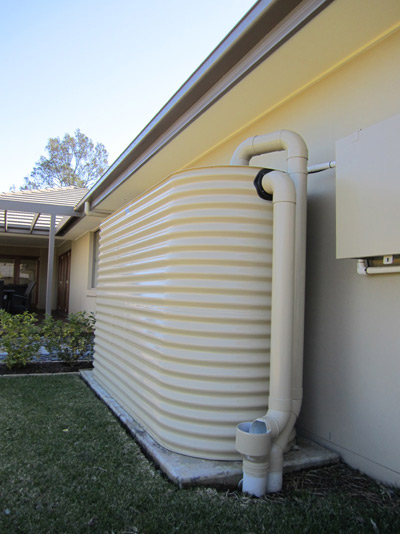
If you’ve made the decision to start saving money on your water bill and install a rainwater tank, you may be considering the best location for your tank.
The best place for your water tank will be somewhere that doesn’t block any pedestrian or vehicle access, is close to a major downpipe, and doesn’t block any windows.
Can a Water Tank be Placed at Ground Level?
Steel water tanks aren’t designed to be placed directly on or in the ground.
Poly and concrete tanks can be installed underground if specifically designed to do so, however require a drastically more significant installation investment including excavation.
We recommend choosing a Bluescope Steel water tank, that not only looks good, but only requires a cost effective concrete pad for installation, no stand required.
This is the most stable and cost effective setup for a base for your steel water tank, and gives you a durable water tank that will be yours to enjoy for years to come.
What’s The Best Base For A Water Tank?
Before you decide the tank location, read through our install guide below to ensure you have enough space for the base.
Water tanks, when filled to capacity, are heavy! They need a sturdy base that’s designed to withstand tonnes of water, depending on your tank capacity.
Learn about the base requirements for our different shape tanks below:
SLIMLINE AND SQUARELINE TANKS
- Concrete pad 100mm thick, for a slimline tank, in the 25MPa range as commonly used for driveways and footpaths and should contain F62 reinforcing mesh. We do not recommend sloping the pad for drainage. Pad size should exceed both the tank length and width by 100mm
ROUND TANKS UNDER 2M (2,000MM) DIAMETER
- Concrete pad of 25mPa concrete or a 100mm thick pad of compacted crusher dust (fine gravel with max 5mm particle size) topped with pavers. Gravel and pavers should be contained by a permanent border (formwork) to prevent the pad being washed away from under the tank. Pad diameter should exceed the tank diameter by 200mm.
ROUND TANKS OVER 2M (2,000MM) DIAMETER
- Concrete pad or a paver base is still suitable, however due to the large surface area of the tank base it is also suitable to construct a 100mm thick pad of compacted crusher dust (fine gravel with max 5mm particle size). The crusher dust should be contained by a permanent border (formwork) to prevent the pad being washed away from under the tank. Pad diameter should exceed the tank diameter by 200mm.
Learn more about tank installation here.
Summary
So choosing the best spot for your new water tank¹ takes a bit of planning and consideration, but once you’ve picked a location that is convenient, getting the base installed and your water tank delivered will be your final steps to harvesting your very own rainwater.
